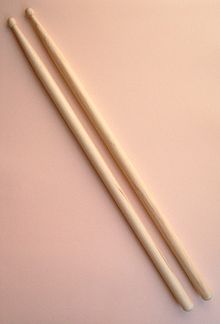Percussion mallet
- This article is about the musical tool. For more meanings, see Drumstick (disambiguation).

A drum stick or drumstick is an object used to strike drums and other percussion instruments to produce sound. Some specialized drum sticks are called beaters, mallets, or brushes.
Snare drum sticks
Snare drum sticks are usually made of wood, often hickory, oak or hard maple. Other used materials include aluminum (covered with a PVC sleeve to avoid damage to cymbals), fiberglass, nylon, acrylic, plastic, and carbon fibre. A typical drum stick is around 1.5cm in diameter and 41cm long, although drummers have a wide range of shapes and sizes to choose from. Many drummers are very particular about the exact shape, size, weight, balance, density, and grain of their sticks. All of these qualities attribute to the "feel" and sound of the stick.
Snare drum sticks may be designed for use in particular performance contexts. Sticks that are smaller in diameter or balanced farther towards the tip may be intended for orchestral playing that requires fine control and soft dynamics. Sticks for street playing (e.g. drum corps and marching bands) are almost always thick and weighty, to promote extended production of sound at extreme dynamics. There are different sizes of drum sticks for each situation, designated by a letter and number, e.g. 2b and 5b are thicker, while 5a and 7a are smaller.
Anatomy of a snare drum stick

The drum head is (usually) struck with the tip of the drum stick. Tips come in many shapes, such as acorn, barrel, oval and round. The tip is sometimes referred to as the bead. Traditionally, the tip is made of the same piece of wood as the rest of the stick, although there are drum sticks with a plastic nylon tip conceived by Joe Calato in Niagara Falls, NY in 1958 and the newer acetal tip, conceived by Ken Drinan and Paul Kiersted in the 1970s. The acetal tip produces a brighter sound when playing cymbals and is less likely to splinter after sustained or violent use. However, it is prone to cracking or flying off.
Immediately below the tip is shoulder of the stick, which tapers out. The rest of the stick is referred to as the shaft, with the butt at the opposite end to the tip. This section of the stick is prone to breaking after or during cymbal use or during rim shots.
Players use two sticks, employing either a matched grip, popularised by Ringo Starr in the 1960s or a traditional grip, popularised by Sanford A. Moeller from talks with American Civil War drummers/veterans. With either grip, players keep the balance point of the stick slightly beyond their hands.
Holding the Drumsticks
see;
HOLD ON TO THEM HARD.
Major Drum Stick Companies
Mallets
A mallet comprises a head connected to a thin shaft. Unwrapped mallets, used on glockenspiel, xylophone and other instruments with keys made of durable material, have heads made of brass, kelon, nylon, acrylic, wood, or other hard materials; wrapped mallets, used on marimba, vibraphone and other instruments with softer keys, have heads of kelon, nylon, acrylic or other medium-hard materials wrapped in softer materials like yarn, cord or latex. Mallet shafts are commonly made of rattan or birch.
Different mallets are used primarily to alter the timbre of the mallet instrument being played. Typically, softer or thicker mallets are used on an instrument's lower registers and harder, thinner mallets used on higher registers. Mallet choice is typically left up to the performer, though some compositions specify if a certain sound is desired by the composer.
Players frequently employ two mallets in a matched grip or four mallets in a four-mallet grip; however, use of up to six mallets is not uncommon. More than two mallets may be used even when no chords are called for by the composer so that the performer has a wider range of timbres from which to select or to facilitate performance of music that moves rapidly between high and low, and if hit properly can switch between the two pitches.
Brushes

Brushes are a set of bristles connected to a handle so that the bristles make a rounded fan shape. The bristles can be made of metal or plastic; handles are commonly made of wood or aluminum, and are often coated with rubber. Some brushes are telescoping, so that the bristles can be pulled inside a hollow handle and the fan made by the bristles can be of variable length, width and density. Retracting the bristles also protects the brush when it is not being used. The non-bristled end of the brush may end in a loop or a ball. Though most performers prefer using metallic brushes, more now use plastic brushes because of their increased durability.
Brushes add texture and sound not possible with sticks. For instance, silky swish sounds on coated heads and the delicate "ting" sound on cymbals are only possible with thin wire or nylon brushes.
Timpani mallets
See Timpani.
External links
- Traditional letter/number scheme for snare drum stick model names.
